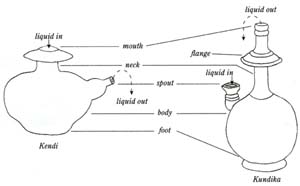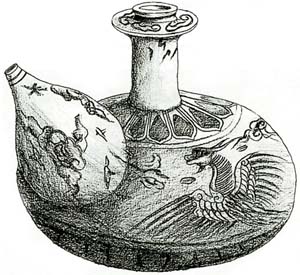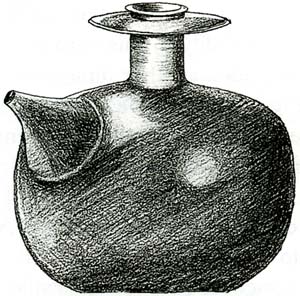Introduction
 |
| White earthenware kendis with a round body, wide neck and a conical spout. Ht. 10-15 cm. Found in East Java. Drawing after Sumarah Adhyatman, 'Kendi'. |
 |
| Kendi forms redrawn from examples in 'Introduction' by Eng-Lee Seok Chee in 'Kendis: A Guide to the Collections, National Museum Singapore'. |
 | | Chinese blue and white porcelain kendi with a bulbous body, tall, narrow neck, flange around the mouth and a mammary spout. Decorated with peony scrolls on the body, a stylized floral motif and religious symbols on the spout, and a band of lotus leaves around the base of the neck and the lower body. 15th century. Ht 15 cm. Adam Malik Museum. Drawing after Sumarah Adhyatman, 'Kendi'. | |
|
Chinese white-glazed porcelain kundika with a tall, narrow neck and a cup-shaped spout with two rings. l0fh century (Early Song Dynasty).
Museum of Ding district, Hebei Province. Drawing after Sumarah Adhyatman, 'Kendi'. |
 |
| Plate 1: Kundika, Borobudur temple, Indonesia, 9th century |
 |
Sawankhalok green-glazed stoneware kendi in the form of
a hamsa (sacred goose). 14th-15th century. Ht. 15.2cm.
Drawing after Honda and Shimazu, 'The Beauty of Fired Clay'. |
 |
Chinese blue and white porcelain kendi with a bulbous body, tall, narrow neck, flange around the mouth and a mammary spout. Decorated with flying phoenix and cloud scrolls on the body, and a band of lotus leaves around the base of the neck and the lower body. 15th century.
Ht. 18 cm. National Museum. Drawing after Sumarah Adhyatman, 'Kendi' |
 |
| Red earthenware kendi with a bulbous body and round base, a short spout and a wide mouth with everted rim. Circa 13th-14th century. Ht. 9 cm. Found in East Java. Adam Malik Museum. Drawing after Sumarah Adhyatman, 'Kendi'. |
 |
| Red earthenware kendi with a round body and a flat base, narrow neck, and a conical spout. Circa 14th-16th century. Ht. 14.1 cm. Found in East Java. Drawing after Sumarah Adhyatman, 'Kendi'. |
Select Bibliography
Adhyatman, Sumarah, 'Kendis, Jars and Other Ceramics: Their Role in Indonesia,1 Paper presented at a conference, Asian Ceramics: Potters, Users, and Collectors,' The Field Museum, Chicago, 7-9 October 1994.
_______ , Kendi, Traditional Drinking Water Container, Jakarta, The Ceramic Society of Indonesia, 1987.
Bhumadhon, Phuthorn, 'Ceramics of the Dvaravati Period in Early Thailand, 6th to 10th Centuries, A.D.' Paper read at the Field Museum's and ACRO's Asian Ceramics Conference, May 1996.
Brown, Roxanna M., The Ceramics of South-East Asia: Their Dating and Identification, 2nd edition, Singapore, Oxford University Press,
1988.
_______ , ed., Guangdong Ceramics from Butuan and other Philippine sites, Manila, the Philippines, Oriental Ceramic Society of the Philippines & Oxford University Press, 1989.
Fisher, Robert E., Buddhist Art and Architecture, London, Thames and Hudson, 1993.
Guy, John, 'Southeast Asian Glazed Ceramics: A Study of Sources,' in New Perspectives on the Art of Ceramics in China, George Kuwayama,ed., Los Angeles County Museum of Art, 1992, pp. 98-114.
Higham, Charles, Early Cultures of Mainland Southeast Asia, Bangkok, River Books, 2002.
Honda, Hiromu and Noriki Shirnazu, The Beauty of Fired Clay: Ceramics from Burma, Cambodia, Laos and Thailand. Introduction by Dawn F. Rooney, Kuala Lumpur, Oxford University Press, 1997.
Indrawooth, Phasook, 'Kendis from Peninsular Thailand, in Muang Boran Journal, vol. 10, no. 1, Jan-Mar 1984.
Kendis: A Guide to the Collections National Museum Singapore, 1984.
Luce, G.H., Old Burma - Early Pagan, Ascona and New York, 1969-70, vol. I.
Nugrahani, D.S., 'Exploring Indonesian Kendi,' TAASA Review, Australia, vol. 5, no. 1, March 1996, pp. 6-7.
Ridho, Abu, White Kendis; Sumarah Adhyatman, Burmese Ceramics Bulletin, Jakarta, The Ceramic Society of Indonesia, May 1985, pp. 42-52.
Rooney, Dawn F., Khmer Ceramics, Singapore, Oxford University Press, 1984.
_________, Folk Pottery in South-East Asia, Singapore, Oxford University Press, 1987.
Sakai, T., The Origin of the Kendi PouringVessel, A Preliminary Note on Its Typological Study,' Journal of East-West Maritime Relations, vol 2,1992 (NB: Waseda University]
Singh, R C. Prasad, 'Spouted Vessels in India,' Potteries in Ancient India, B. P. Sinha, ed, Patna, Department of Ancient Indian History and Archaeology, Patna University, 1969, pp. 118-123.
Soegondho, Santoso, Earthenware Traditions in Indonesia: From Prehistory until the Present, Jakarta, Ceramic Society of Indonesia, n. d..
Spinks, Charles Nelson, The Ceramic Wares of Siam, Bangkok, The Siarn Society, 1965.
Stark, Miriam, 'Pre-Angkor Earthenware: Ceramics from Cambodia's Mekong Delta,' UDAYA Qournal of Khmer Studies), April 2000, pp. 69-89.
Sweetman, John and Nicol Guerin, The Spouted Ewer and its relatives in the Far East, An Oriental Ceramic Society exhibition in the Barlow Gallery. University Library, Falmer, Brighton, University of Sussex, 1983.
Endnotes
i Fisher (1993) Thames and Hudson, pit 95, p. 103.
ii Nugrahani (March 1996) 'Exploring Indonesian kendi', TAASA Review, vol.5, no.l, pp.6-7).
iii Bhumadhon (May 1996).
iv Personal conversations with the Director, October 2001.
v Higham (2002) River Books, p.236.
vi Stark (April 2002), p.79.
vii For examples of Satingpra-type ware, see Guangdong Ceramics, pit 150-4.
viii Guy (1992)
-----
text and image source :http://rooneyarchive.net/articles/kendi/kendi_album/kendi.htm
 Kendi uit V.O.C.-schip de 'Witte Leeuw',
Kendi uit V.O.C.-schip de 'Witte Leeuw',







